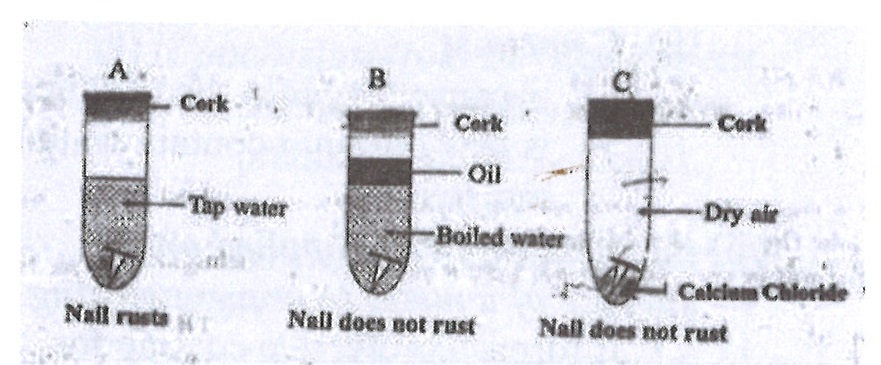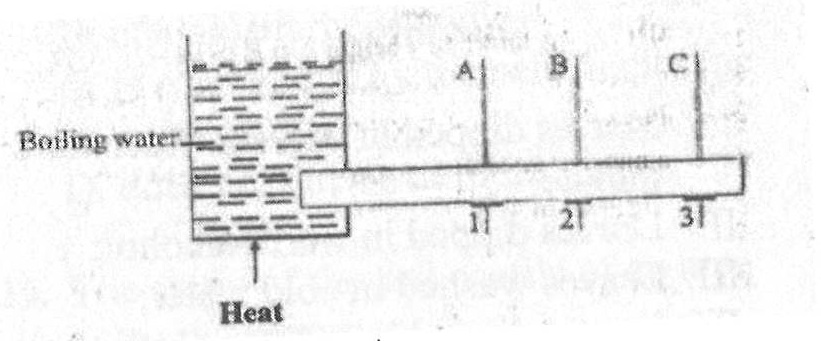1.
Steel is an alloy of iron and
aluminium.
carbon.
silicon.
gold.
2.
An atom that has lost one or more electron(s) is called
a molecule.
a proton.
am ion.
a negative particle.
3.
In all machines, the efficiency is
always 100%
less than 100%
more than 100%
always 0%
4.
In electronic circuits, LEDs are used to indicate the absence or presence of
voltage source.
p-n junction.
electric current.
emitted and collector.
5.
Which of the following statements about the scientific method is/are correct? It provides
I. logical procedure for arriving at knowledge.
II. knowledge that can never be changed.
III. knowledge that can never be changed.
I only
I and II only
I and III only
II and III only
6.
Which of the following substances is a compound?
Hydrogen
Nitrogen
Oxygen
Water
7.
Which of the following source(s) of energy is/are renewable?
I. Solar
II. Crude oil
III. Wind
I only
I and II only
I and III ONLY
I, II and III
8.
The pressure in fluids
increase with depth.
decrease with depth.
acts upwards at any point.
acts differently in all directions.
9.
Which of the following chemical equations is balanced?
N2+H2→NH3
N2+3H2→NH3
N2+H2→2NH3
N2+3H2→2NH3
10.
Lime juice taste sour because it is
acidic.
alkaline.
basic.
salty.
11.
A metal block has a mass of 1.0 kg. What is the volume of the block if its density is 10 kg m-3?
0.01 m3
0.10 m3
1.00 m3
10.00 3
12.
It is easier to move a heavy load with a crowbar when the
effort distance is shorter than the load distance.
effort distance is longer than the load distance.
effort distance is equal to the load distance.
effort is equal to the load.
13.
Benedict's solution was added to a mixturein a test tube and it turned brick red when heated. The mixture is likely to contain
glucose.
vitamin.
protein.
oil.
14.
Chlorine gas in a example of
an atom.
an element.
a compound.
a molecule.
15.
Which of the following statements about a force are correct? It
I. is measured in newtons.
II. is measured in newton-metre.
III. can start a motion.
IV. can change the direction of a moving body.
I and II only
I and III only
I, III and IV only
I, II, III and IV
16.
Kerosine is able to reach the other end of a wick by
diffusion.
suction pressure.
capillary action.
osmosis.
17.
Which of the following chemical compounds is used in removing hardness in water?
NaCl
NaOH
Na2CO3
NaHCO3
18.
Which of the following processes is used separate insoluble solids from liquids?
Sublimation
Filtration
Evaporation
Crystallization
19.
When a thermometer is put in hot water, the mercury level rises because the mercury increases in
density.
mass.
volume.
weight.
20.
The work done when a force moves a body through a distance of 12 m is 720 J. The force applied is
8640 N.
732 N.
708 N.
60 N.
21.
Which of the following compounds is neutral to litmus paper?
HCL
H2O
NaOH
KOH
22.
A balanced diet is one which is made up of
right proportions of protein, carbohydrates and oils.
equal amounts of protein, carbohydrates and oil.
enough water and iodated salt.
vegetables, fruits and water.
23.
The ovules in a flower develop to form the
fruit.
leaf.
seed.
stem.
24.
Water drains faster through sand than clay because
sand particles are rougher.
sand contains more air space.
clay particles are smoother.
clay particles are bigger.
25.
The best method for checking erosion on a slope is
cover cropping.
mixed cropping.
contour ploughing.
mulching.
26.
The housefly is an agent for the spread of
cholera.
malaria.
measles.
tuberculosis.
27.
Which of the folloeing substances are carried by the blood?
I. Nutrients
II. Urine
III. Oxygen
IV. Carbon dioxide
II and III only
I, II and IV only
I and III only
I, III and IV only
28.
Which of the following statements about a plant cell is correct? It
does not have a nucleus.
contains large vacuoles.
is surrounded by the cell membrane only.
does not have a definite shape.
29.
The study of the soil profile of an area helps the farmer to
control weed growth.
determine the soil temperature.
determine the types of crops to grow.
know the pesticides to use.
30.
The term leaching in soils refers to
accumulation of organic matter.
decomposition of plant materials.
fixation of nitrogen.
removal of soil nutrients by water.
31.
How many stages does the mosquito go through in its life cycle of development?
1
2
3
4
32.
Which of the following enzymes helps in digestion of protein in the human stomach?
I. Proteases
II. Amylase
III. Lipases
I only
II only
I and II only
II and III only
33.
Kidneys absorbs water from the blood stream of humans through the processes of
diffusion.
egestion.
osmosis.
assimilation.
34.
Am example of soil micro-nutrients is
copper.
calcium.
phosphorus.
potassium.
35.
The vegetable crop that requires staking during its growth is
sweet pepper.
garden eggs.
tomatoes.
hot pepper.
36.
The function of the white blood cells in humans is to
produce haemoglobin.
produce digestive enzymes.
ensure blood clot during an injury.
produce antibodies to fight disease causing organisms.
37.
The carpel of a flower is made up of the following parts except
filament.
ovary.
style.
stigma.
38.
A food web shows how
food produce by plants is distributed to other parts of the plant.
an organism protects itself in its environment.
organisms depends on one for shelter.
food produced by green plants is distributed among organisms in a community.
39.
Balanced ration enables animals to
increase fertility rate.
maintain normal growth.
increase meat production.
maintain energy level of work animals.
40.
Cultural practices are activities undertaken on a farm
after harvesting and before processing.
before maturity and after harvesting.
after planting and before harvesting.
before transplanting seedling.
a)
In an experiment the surfaces of three iron nails were cleaned dry and placed in three separate test tubes A, B and C as shown in the diagram.
Study the diagram carefully and answer the questions that follow.

After three days the nail in the test tube A was found to have rusted while the nail in test tubes B and C did not rust.
i)
Suggest an aim for the experiment.
ii)
Why was the water in test tube B boiled?
iii)
State the function of the oil on top of the water in test tube B.
iv)
What is the purpose of the calcium chloride in test tube C?
v)
Why did the nail in test tube A rust?
vi)
Why did the nail in test tube
α)
B not rusted?
β)
C not rusted?
vii)
From the experiment, explain why oil is applied on the surface of a metal to prevent rusting.
b)
In an experiment, the following activities were carried out on two green leaves A and B.Leaf A was taken from a plant placed in the sunlight for some time while leaf B was taken from a plant placed in a dark cupboard for 24 hours.
Activity
I. Leaves dipped in boiling water for 1 minute;
II. Leaves dipped in warm alcohol;
III. Leaves washed in cold water;
IV. Leaves dipped in iodine solution.
After dipping in the iodine solution, it was observed that leaf A changed colour.
Study the activities carefully and answer the questions that follow.
i)
Suggest an aim for the experiment.
ii)
Explain briefly why each of the following activities were carried out:
(α) I;
(β) II;
(γ) III.
iii)
State the colour change of leaf A.
iv)
Explain why leaf A changed colour?
v)
Why is it necessary to de-starch the plant before starting the experiment?
vi)
From the above experiment, what conclusion(s) can be drawn.
c)
You are provided with two dry soil samples A and B, a measuring cylinder, beakers, funnels, filter paper, beam balance, stop watch and water. With the aid of a labelled diagram, describe an experiment to find out which of the two soil samples can hold more water.
d)
The diagram below is an illustration of an experiment that was carried out. In the experiment three pins 1, 2 and 3 were fixed with candle wax onto a metal bar and one end of the bar was heated by means of boiling water. A, B and C are thermometers inserted in holes along the bar to measure the temperature at the various points.
Study the diagram carefully and answer the questions that follow.

i)
Suggest an aim for the experiment.
ii)
What is the temperature of the boiling water?
iii)
State the observation that would be made about the pins 1, 2 and 3.
iv)
State the observation that would be made about the temperatures recorded by the thermometers A, B and C.
v)
State how heat from the sun is transmitted to the earth.
a)
i)
What is a food chain?
ii)
Why is the plant in any food chain referred to as producer?
iii)
What is the term given to the other organisms that depend directly or indirectly on the producer for food.
b)
The diagram below is an illustration of the picture obtained on a screen when an opaque object is placed in the in the path of a light source.
Study the diagram carefully and answer the questions that follow.

i)
Name each of the shadows that is cast on the screen:
α)
A;
β)
B.
ii)
What does the shadow of the object cast on the screen illustrate?
c)
Describe briefly how a sample of pure sugar could be obtained from a mixture of sugar and sand.
d)
State three ways by which soil can be conserved.
a)
A body of mass 100 kg is raised to a height of 2 m above the ground.
i)
State the name of the energy possessed by the object by reason of the new position.
ii)
Calculate the value of this energy.
[g = 10 ms-2]
b)
i)
What is matter?
ii)
State two of the states of matter.
c)
i)
Describe the nature of a loamy soil.
ii)
Name any two plants nutrients.
d)
i)
State the causative organism for each of the following diseases:
α)
cholera;
β)
tuberculosis.
ii)
State one method of prevention of cholera.
a)
Explain briefly why a tomato plant is likely to wilt if too much fertilizer is applied.
b)
State the dangers involved in each of the following activities in the laboratory:
i)
eating or drinking water in the laboratory;
ii)
walking barefooted;
iii)
washing hands with unknown liquid in a beaker.
c)
A child is found not to be able to see at night.
i)
What deficiency disease may the child be suffering from?
ii)
What food nutrient is the child lacking?
iii)
State three source of food substances that can provide the nutrient that the child lacks.
d)
i)
What is a force?
ii)
Explain briefly why a driver could not stop a car on a slippery section of a road when he applied the brake.
a)
Describe briefly how the volume of an irregular shaped lead ball could be measured.
b)
State three characteristics of living things.
c)
i)
What is pollution?
ii)
Name one air pollutant.
d)
State three factors which influence vegetable crop production.
a)
State three ways in which crop rotation is important in crop production.
b)
State three properties of the image formed by a plane mirror.
c)
i)
What is photosynthesis?
ii)
Explain briefly why a digestive system is necessary in humans.
d)
Give the systematic name of the following compounds:
i)
α)
MgCl2;
β)
FeS.
ii)
What is an element?
iii)
What is the name given to a solid mixture?